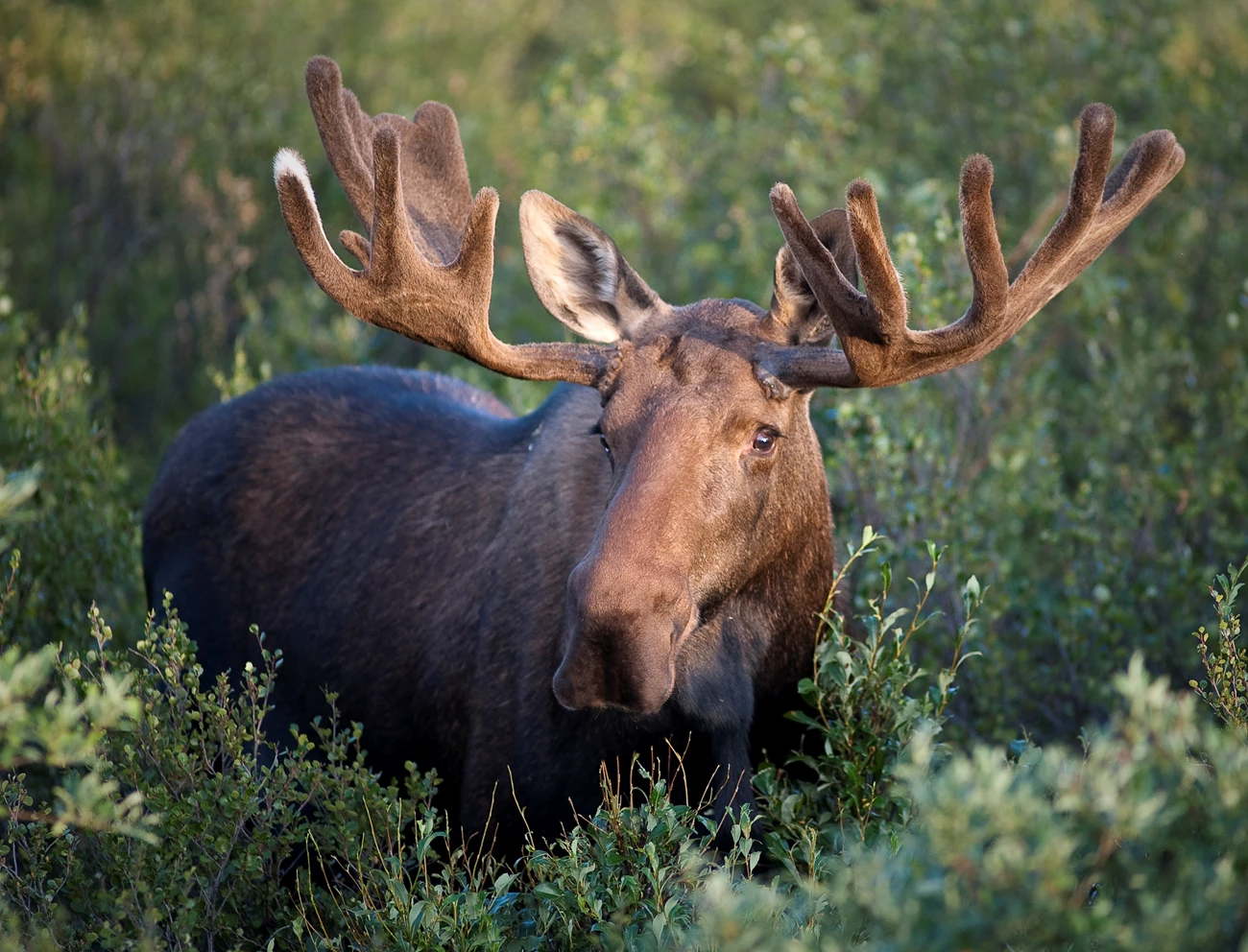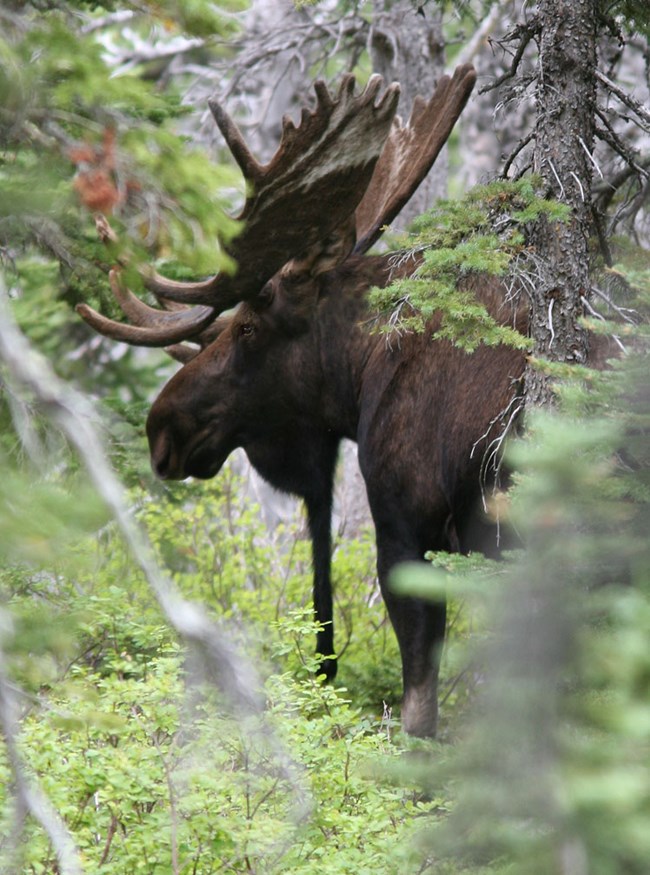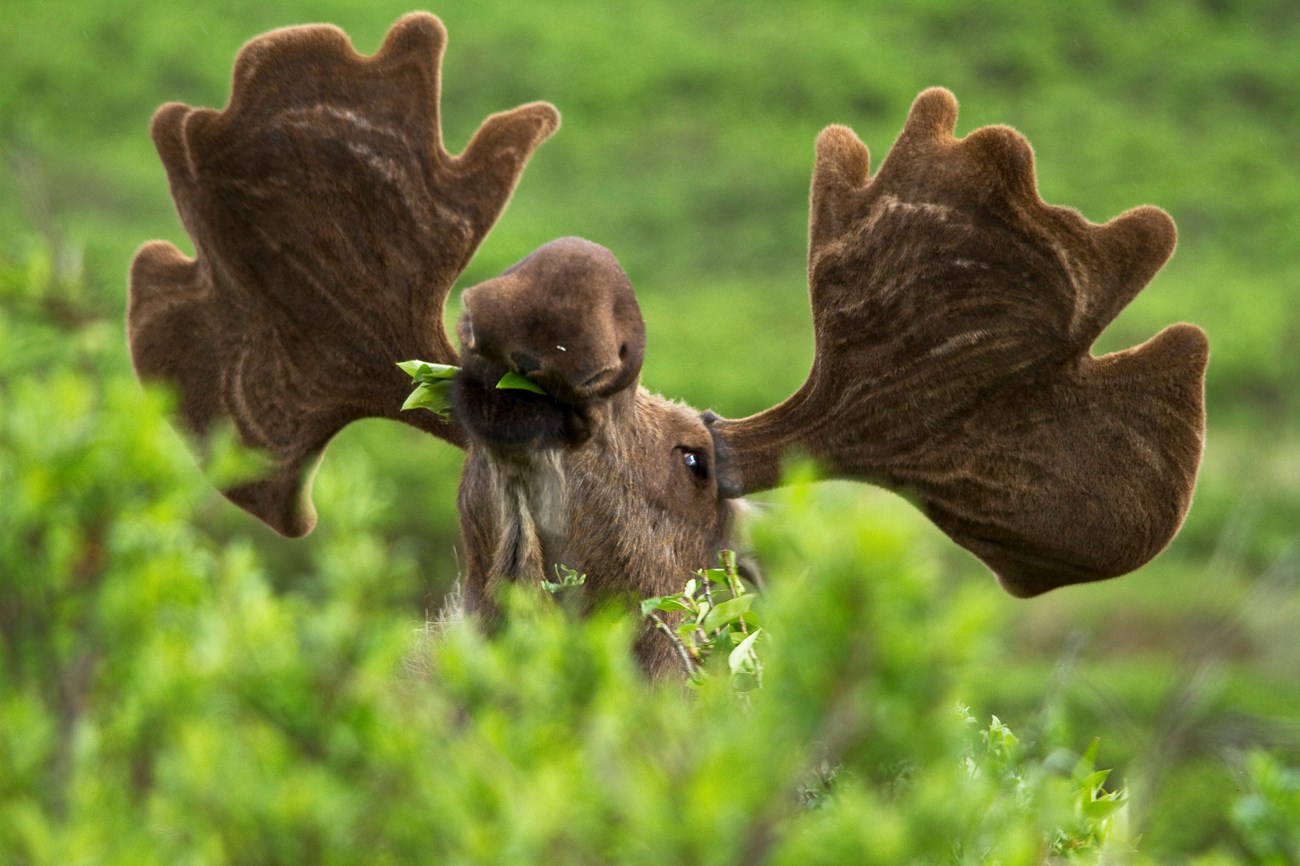Last updated: May 23, 2025
Article
Moose: Giants of the North Woods

NPS / Kent Miller

Ed Sharron
If you live in northern North America you have likely uttered the words “eater of twigs” in another language many times without knowing it. For that is the translation of the Algonquian Indian word “moose.”
Native American tribes used moose for food, clothes, and tools. Many tribes still see moose as sacred animals that stand for strength, wisdom, courage, and never giving up.
Awesome Antlers and Dangling Dewlaps
Male moose (called bulls) have two things that make them really stand out. First, they have huge antlers! These antlers can be 6 feet wide and weigh more than 60 pounds. That's like carrying a kid on your head all day! Bulls use their antlers to fight other males and show off to female moose (called cows).
Second, they have this weird flap of skin and hair hanging under their chin called a dewlap. Scientists aren't totally sure what it's for, but they think it might help with staying cool or attracting mates. Dewlaps may play a part in mating rituals by helping spread the scent (from urine and saliva) of a bull when it rubs a cow with its chin. It's biggest on young bulls between 3 and 5 years old. Fun fact: these dewlaps can actually freeze and break off in super cold weather!
Moose and Meadows
Moose work together with beavers and tiny mice called voles to create something amazing called beaver meadows. It happens like this:
- Beavers cut down aspen trees to eat the branches
- When the trees try to grow back, moose eat them up
- This lets spruce and fir trees grow instead, making a thick forest wall
- The beavers can't get to the aspen trees anymore, so they leave
- Their dam breaks down, the pond drains, and you get a grassy meadow!
But here's the crazy part - these meadows can stay open for decades without trees taking over. Why? It's all about tiny underground fungi called mycorrhizae. These fungi are like best friends with tree roots. The fungi give trees food, and trees give fungi sugar. It's the perfect friendship!
When the beaver pond covers the ground, it kills all these helpful fungi. So even when the pond drains, new trees can't grow because they don't have their fungus friends.
But wait, there's more! Two types of voles (tiny mouse-like animals) keep the meadows open. Red-backed voles live in the forest and eat the fungi, spreading them in their poop. But meadow voles are super mean to red-backed voles and chase them away from the meadows. No red-backed voles means no fungi spreading, which means no new trees!

Ed Sharron
Creatures of the Cold
Moose are basically ice age animals. They evolved about 500,000 years ago when the world was much colder. With their big bodies, long legs, and thick fur, they're built for deep snow and freezing temperatures.
But now the world is getting warmer, and moose are in trouble. They get stressed when it's hot, and warmer weather brings diseases and nasty bugs. Moose numbers are dropping fast:
- New Hampshire: down 40% since 2014
- Vermont: down 50% since 2005
- Maine: down 22% since 2012
- Minnesota: down 58% between 2006 and 2017

NPS / Jacob W. Frank
Tiny Enemies Cause Big Problems
Even though moose are huge (some weigh 1,500 pounds!), they have two tiny enemies that are causing major trouble.
Brain Worms: The Sneaky Hitchhikers
White-tailed deer carry parasites called brain worms. These worms don't hurt deer much, but they're deadly to moose. Here's how it works:
- Deer poop out worm eggs
- Snails and slugs eat the eggs
- Moose accidentally eat the snails while munching on plants
- The worms travel to the moose's brain and spinal cord
- This makes the moose act weird - they might walk in circles, go blind, or become paralyzed
- Eventually, the moose dies
Deer used to stay south where there's less snow, but warmer winters mean they're moving north into moose territory, bringing their deadly hitchhikers with them.
Winter ticks are like tiny vampires that suck moose blood. Because winters are getting warmer, there are way more ticks now. And moose aren't very good at grooming themselves to get rid of them.
Some moose have been found with 90,000 ticks on them! Each tick drinks about one milliliter of blood. That means 90,000 ticks can drink almost 24 gallons of blood from one moose. This makes moose so weak that many die from blood loss. Female moose with lots of ticks also have trouble having babies.
Fighting Back: How Scientists Are Helping
Scientists are trying different ways to help moose:
Reducing Moose Numbers: This might sound backwards, but in some places, there are too many moose close together. This makes it easy for ticks to jump from one moose to another. By reducing moose numbers in crowded areas (like social distancing for moose!), there are fewer ticks.
Fungus Fighters: Scientists are testing special fungi that naturally live in New England soil. These fungi can kill ticks! They spread the fungi using oils, powders, or little pellets. When ticks touch the fungi, it gets inside their bodies and kills them.
The Future of Moose
Moose have survived ice ages and many other challenges, but climate change is their biggest test yet. These amazing "eaters of twigs" need our help to keep living in the forests they call home. By understanding how moose, beavers, fungi, and even tiny voles all work together, scientists hope to find ways to protect these incredible giants of the north woods.
Next time you're in moose country, remember - you're not just looking at a big animal with funny antlers. You're seeing a survivor, a forest engineer, and one of nature's most amazing creatures!
Learn More about Moose and Science on Isle Royale National Park
- Duration:
- 4 minutes, 34 seconds
In this episode of Outside Science (inside parks), follow young scientists as they study how moose populations are impacting the island.
